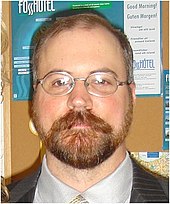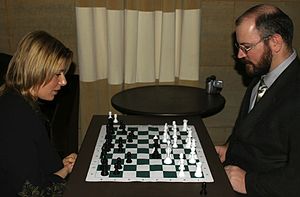This is an old revision of this page, as edited by Donaldstrumpcard (talk | contribs) at 20:19, 26 January 2009 (→Gothic Chess). The present address (URL) is a permanent link to this revision, which may differ significantly from the current revision.
Revision as of 20:19, 26 January 2009 by Donaldstrumpcard (talk | contribs) (→Gothic Chess)(diff) ← Previous revision | Latest revision (diff) | Newer revision → (diff)| Ed Trice | |
|---|---|
 | |
| Full name | Edward A. Trice |
| Country | |
Edward A. Trice (born December 5, 1966 in Philadelphia, Pennsylvania) is an American inventor and entrepreneur. He invented a chess variant known as Gothic chess, and has created several chess and checkers programs. He is a USCF rated Class-D chess player with a rating of 1303. He is also a Gothic Chess expert with a Gothic Chess rating of 2046.
Chess
Trice wrote a chess program called The Sniper. The Sniper ran on processors no faster than 7 MHz. In 1989, he won an exhibition game against the Deep Thought chess program in 20 moves, its quickest loss ever.
Gothic Chess
Main article: Gothic Chess
In 2000, Trice patented the commercial chess variant Gothic Chess, derived from Capablanca Chess. This variant differs from Capablanca Chess in the initial positioning of some of the back-row pieces.
Collaborating with Gil Dodgen, they produced a Gothic Chess program named Gothic Vortex, which was based on the chess program Crafty by Robert Hyatt. In 2004, the first ever Gothic Chess Computer World Championship was held, fielding entrants from four different countries. Gothic Vortex, with its ability to announce checkmate from a distance of 268 moves, won by the score of 14-0.
Checkers
In 2003, Trice and Dodgen demonstrated that it was possible for a checkers program to fail to win a theoretically-won position with as few as seven pieces on the board (four for the winning side, three for the side that should lose). Their World Championship Checkers computer program was the first to use a so-called "Perfect Play Lookup" database to demonstrate how to potentially postpone a loss indefinitely. Dodgen and Trice were the first to implement such technology. In 2007, Jonathan Schaeffer solved the game of checkers, and acknowledged Trice and Dodgen's database verification.
References
- "Ed Trice's member details and tournament history at the USCF". Retrieved 2009-15-01.
{{cite web}}: Check date values in:|accessdate=(help) - "Ed Trice's ranking at the Gothic Chess website". Retrieved 2009-15-01.
{{cite web}}: Check date values in:|accessdate=(help) Trice plays under the handle "GothicInventor". - "Ed Trice vs. Deep Thought". Retrieved 2009-15-01.
{{cite web}}: Check date values in:|accessdate=(help) - "Losses of Deep Thought". Retrieved 2009-15-01.
{{cite web}}: Check date values in:|accessdate=(help) - "Ed Trice vs. Susan Polgar". Retrieved 2007-10-25.
- Trice E (2004). "80-Square Chess" (PDF). ICGA Journal. 27 (2): 81–96. Retrieved 2007-07-28.
{{cite journal}}: Unknown parameter|month=ignored (help) - "Gothic Chess Computer World Championship". Retrieved 2009-15-01.
{{cite web}}: Check date values in:|accessdate=(help) - Trice E, Dodgen G (2003). "The 7-Piece Perfect Play Lookup Database for the Game of Checkers" (PDF). ICGA Journal. 26 (4): 229–238. Retrieved 2009-01-15.
{{cite journal}}: Unknown parameter|month=ignored (help) - "World Championship Checkers website". Retrieved 2007-07-27.
- Schaeffer, J (2007-07-19). "Checkers Is Solved". Science. Retrieved 2007-07-20.
- Schaeffer, J. "Acknowledgements". Retrieved 27 July.
{{cite web}}: Check date values in:|accessdate=(help); Cite has empty unknown parameter:|1=(help); Unknown parameter|accessyear=ignored (|access-date=suggested) (help)